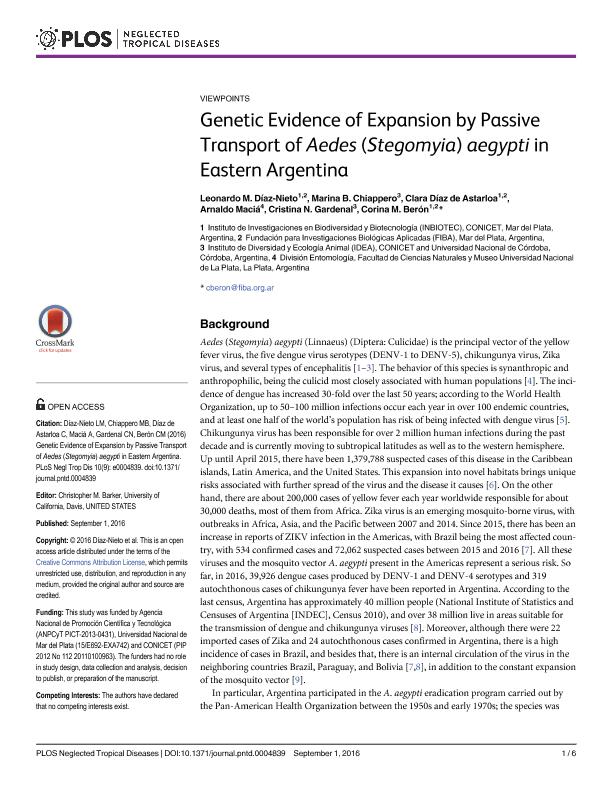Mostrar el registro sencillo del ítem
dc.contributor.author
Díaz Nieto, Leonardo Martín

dc.contributor.author
Chiappero, Marina Beatriz

dc.contributor.author
Díaz de Astarloa, Clara
dc.contributor.author
Maciá, Arnaldo

dc.contributor.author
Gardenal, Cristina Noemi

dc.contributor.author
Berón, Corina Marta

dc.date.available
2017-09-11T18:16:06Z
dc.date.issued
2016-09
dc.identifier.citation
Díaz Nieto, Leonardo Martín; Chiappero, Marina Beatriz; Díaz de Astarloa, Clara; Maciá, Arnaldo; Gardenal, Cristina Noemi; et al.; Genetic evidence of expansion by passive transport of Aedes (Stegomyia) aegypti in Eastern Argentina; Public Library of Science; Neglected Tropical Diseases; 10; 9; 9-2016; 1-6
dc.identifier.issn
1935-2735
dc.identifier.uri
http://hdl.handle.net/11336/23910
dc.description.abstract
Aedes (Stegomyia) aegypti (Linnaeus) (Diptera: Culicidae) is the principal vector of the Yellow Fever virus, the Dengue virus serotypes, Chikungunya virus and several types of Encephalitis. The behavior of this species is strictly synanthropic and anthropophilic, and it is the culicid most closely associated with human populations. In March 2011 and 2012 our group reported a new biogeographical record of A. aegypti in the southeast of Argentina. In order to determine the origin of the A. aegypti population?s distribution present in this new expansion area, we analyzed the mitochondrial lineages of these mosquito populations and compared their haplotypes with the haplotypes previously determined by Albrieu Llinás and Gardenal (2012) in Argentina and neighboring countries. The sampling stations were cemeteries and used tires located in towns next to the Provincial Route No 2 and in Buenos Aires city, La Plata (both at 400 km north from Mar del Plata) and San Clemente del Tuyú, a small town located on the Atlantic coast at 328 km south from Buenos Aires city, where this mosquito species was found for the first time. A 450 bp fragment of the ND5 gene was amplified by the polymerase chain reaction from a DNA extraction of each single larva. DNA sequences were identified and the haplotype frequencies for each population were calculated. In this work we report the presence of only two haplotypes in the new distribution area. H1 haplotype was detected in all localities analyzed, while H2 was only in two localities. According to our results only passive migration through human transport may explain the observed patterns, demonstrating once again the urgent need to implement serious campaigns to control vector mosquitoes and consequently the development of responsible control campaigns of the mosquito-borne diseases.
dc.format
application/pdf
dc.language.iso
eng
dc.publisher
Public Library of Science

dc.rights
info:eu-repo/semantics/openAccess
dc.rights.uri
https://creativecommons.org/licenses/by/2.5/ar/
dc.subject
Aedes Aegypti
dc.subject
Dispersal
dc.subject
Dengue
dc.subject
Argentina
dc.subject.classification
Bioquímica y Biología Molecular

dc.subject.classification
Ciencias Biológicas

dc.subject.classification
CIENCIAS NATURALES Y EXACTAS

dc.title
Genetic evidence of expansion by passive transport of Aedes (Stegomyia) aegypti in Eastern Argentina
dc.type
info:eu-repo/semantics/article
dc.type
info:ar-repo/semantics/artículo
dc.type
info:eu-repo/semantics/publishedVersion
dc.date.updated
2017-07-27T12:34:36Z
dc.journal.volume
10
dc.journal.number
9
dc.journal.pagination
1-6
dc.journal.pais
Estados Unidos

dc.journal.ciudad
San Francisco
dc.description.fil
Fil: Díaz Nieto, Leonardo Martín. Consejo Nacional de Investigaciones Científicas y Técnicas. Centro Científico Tecnológico Conicet - Mar del Plata. Instituto de Investigaciones En Biodiversidad y Biotecnología; Argentina. Fundación para Investigaciones Biológicas Aplicadas; Argentina
dc.description.fil
Fil: Chiappero, Marina Beatriz. Consejo Nacional de Investigaciones Científicas y Técnicas. Centro Científico Tecnológico Conicet - Córdoba. Instituto de Diversidad y Ecología Animal. Universidad Nacional de Córdoba. Facultad de Ciencias Exactas Físicas y Naturales. Instituto de Diversidad y Ecología Animal; Argentina
dc.description.fil
Fil: Díaz de Astarloa, Clara. Fundación para Investigaciones Biológicas Aplicadas; Argentina. Consejo Nacional de Investigaciones Científicas y Técnicas. Centro Científico Tecnológico Conicet - Mar del Plata. Instituto de Investigaciones En Biodiversidad y Biotecnología; Argentina
dc.description.fil
Fil: Maciá, Arnaldo. Consejo Nacional de Investigaciones Científicas y Técnicas. Centro Científico Tecnológico Conicet - la Plata. Centro de Estudios Parasitologicos y de Vectores. Universidad Nacional de la Plata. Facultad de Cs.naturales y Museo. Centro de Estudios Parasitologicos y de Vectores; Argentina
dc.description.fil
Fil: Gardenal, Cristina Noemi. Consejo Nacional de Investigaciones Científicas y Técnicas. Centro Científico Tecnológico Conicet - Córdoba. Instituto de Diversidad y Ecología Animal. Universidad Nacional de Córdoba. Facultad de Ciencias Exactas Físicas y Naturales. Instituto de Diversidad y Ecología Animal; Argentina
dc.description.fil
Fil: Berón, Corina Marta. Consejo Nacional de Investigaciones Científicas y Técnicas. Centro Científico Tecnológico Conicet - Mar del Plata. Instituto de Investigaciones En Biodiversidad y Biotecnología; Argentina. Fundación para Investigaciones Biológicas Aplicadas; Argentina
dc.journal.title
Neglected Tropical Diseases

dc.relation.alternativeid
info:eu-repo/semantics/altIdentifier/doi/http://dx.doi.org/10.1371/journal.pntd.0004839
dc.relation.alternativeid
info:eu-repo/semantics/altIdentifier/url/http://journals.plos.org/plosntds/article?id=10.1371/journal.pntd.0004839
Archivos asociados
